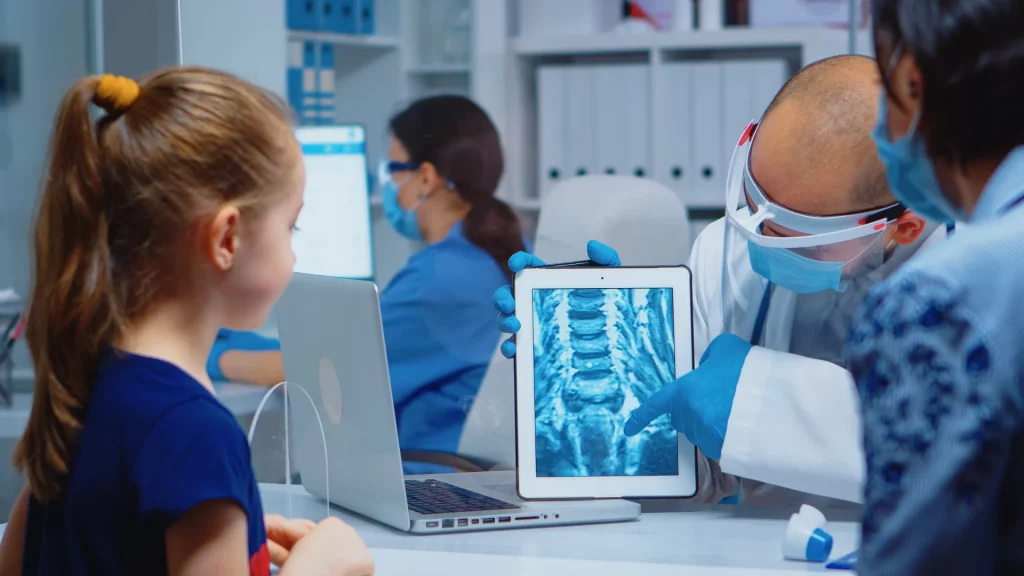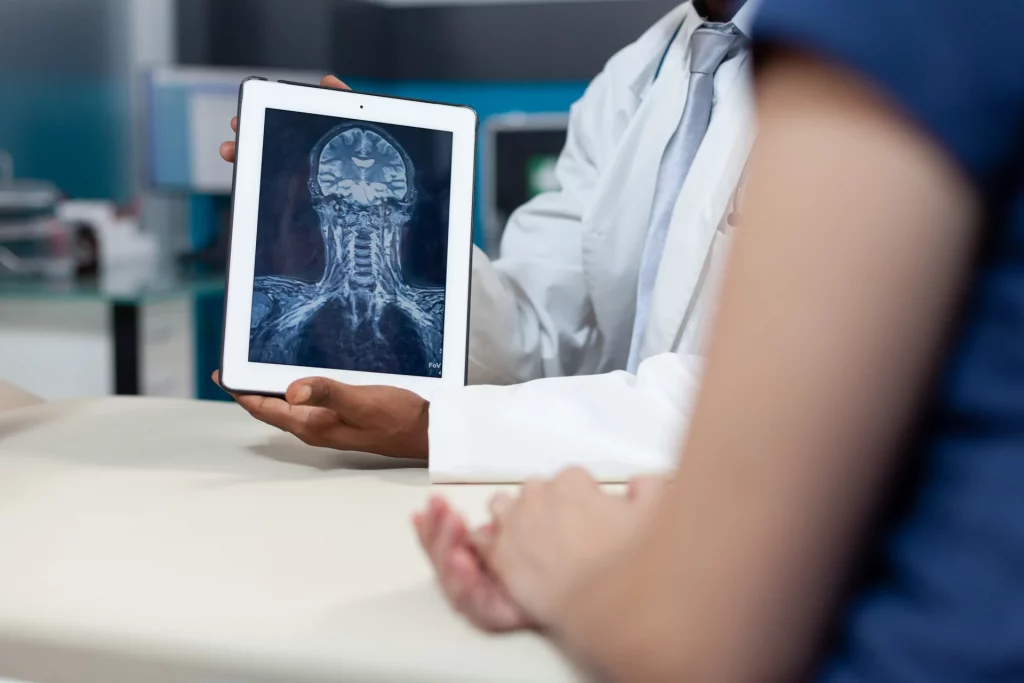Table of Contents
Remote radiology has been explored for nearly 50 years, with teleradiology systems becoming commercially available in the 1980s. However, it wasn’t until the last 10-12 years that this industry really took off due to advances in technology.
Multiple factors have aided its growth, such as the implementation of AI, the rise of large clinical and research communities that share resources online, and new protocols for the exchange of medical data. The increased speed of internet communication around the world has also helped transmit high-level, detailed images faster. Among these factors, the benefits of AI in radiology stand out, enhancing image interpretation accuracy, reducing diagnostic delays, and supporting radiologists in prioritizing critical cases.
The pandemic was also a turning point, as there was an increase in demand for online health solutions. As teleradiology systems are increasingly adopted, the global teleradiology market is expected to reach $6.28 billion in 2030.
So how does remote radiology encompass a modern approach to healthcare?
Teleradiology offers improved patient care, better use of resources, and a variety of other benefits. To better understand this relatively new field of radiology, let’s explore the technical foundations, clinical aspects, and legal considerations of online radiology.
What is Remote Radiology?
Remote radiology, or teleradiology, is a system in which medical images are transferred from one location to another to be interpreted and diagnosed from a remote location. By leveraging digital communication technologies, healthcare professionals have greater access to radiology services, can work together from various locations, and can improve patient outcomes.
Technical Foundations of Remote Radiology
Innovative technology is used to build a strong foundation in online radiology. For a deeper understanding of the technical requirements of radiology software, let’s take a look at the essential equipment and software, image transmission and storage, and telecommunication technologies.
Essential Equipment and Software
Remote radiologists require specific equipment to properly perform their job. This includes, but is not limited to:
- Image Acquisition Devices: These devices capture unprocessed images and convert them to images that can be processed by computers. Radiologists use image acquisition devices to produce high-quality images that improve diagnostic accuracy.
- PACS (Picture Archiving and Communication System): This system stores, retrieves, presents, and transports medical images. PACS can handle various types of images from different imaging devices, enabling easy access and improving efficiency.
- DICOM Standards: DICOM is the international standard to transmit, store, retrieve, print, process, and display medical imaging information. This is a critical component that radiologists must consider when choosing software.
- Radiology Information Systems: Radiology information systems (RIS) store and manage medical image data. There are various types of systems available, including integrated RIS, standalone RIS, cloud RIS, web RIS, and mobile RIS.
Image Transmission and Storage
Image transmission and storage are key components of online radiology. In order to securely share, access, and manage data, developers must consider:
- Data Compression Techniques: Data compression techniques reduce the size of medical images to save storage space and minimize transmission time. There are two common data compression techniques – lossy and lossless. Lossy is a technique that removes insignificant pieces of data to reduce its size, while lossless transforms data through coding. In addition to compression, is also imporant to clean up data and remove duplicate images to otimize storage usage.
- Secure Network Requirements: Teleradiology software requires strict security standards to ensure compliance and confidentiality. This may include encryption, secure transmission protocols, regular security audits, and more.
- Cloud Storage Solutions: Cloud-based solutions make medical images available on any device, at any time, from anywhere in the world. This is a great way to connect patients, radiologists, and other healthcare providers with up-to-date information. Depending on the needs of the project, developers may choose public, private, hybrid, or community cloud solutions.
- Data Security and Encryption: Ensuring secure transmission of medical images is key to protecting patient privacy and complying with regulations. There are different strategies that developers can implement to guarantee secure software development, such as SSDLC. SSDLC incorporates security principles from the start of development, working to identify potential risks, incorporate secure coding practices, and perform security testing and ongoing monitoring.
Telecommunication Technologies
Both radiologists and patients can benefit from proper communication channels. Three important telecommunication technologies in remote radiology are:
- Bandwidth and Connectivity Requirements: Bandwidth refers to the capacity at which a network can transmit data. For successful telehealth app development, both bandwidth and connectivity requirements must be met, which may include a dedicated network infrastructure, secure VPN connections, remote access solutions, and more.
- Video Conferencing Tools: Video conferencing tools for radiology have gained popularity in recent years, facilitating consultations and collaborations. Tools such as Zoom and Teams help remote radiology teams connect quickly and securely. However, organizations that create their own software have the unique opportunity to include video conference features in their custom radiology software.
- Mobile Technologies in Radiology: A growing area in telemedicine software development is mobile radiology applications. In fact, one review of smartphones, tablets and mobile applications for radiology states that mobile applications may be used for diagnostic reading, reference, learning, consultation, and communication with patients, offering new opportunities for diagnostic imaging practitioners.

Clinical Aspects of Remote Radiology
Anyone interested in investing in remote radiology must be aware of the clinical aspects of this field. Here are some of the focal points to consider:
- Types of Radiological Examinations Conducted Remotely: High-tech software allows radiologists to examine different types of medical imagery, including X-rays, ultrasounds, MRIs, mammography, and dental X-ray images.
- Quality Control in Image Interpretation: Equipment should undergo constant monitoring, evaluation, and maintenance to ensure accuracy and compliance. Quality assurance programs can be utilized to monitor the success or areas of improvement in remote image interpretation. There are systems available to help detect deficiencies in each specific field, such as this quality control programme for radiography and mammography equipment.
- Collaborative Diagnosis with Other Specialists: Remote radiology allows radiologists and other health professionals to collaborate from anywhere in the world, reducing turnover time and offering subspecialty interpretations. For this to be possible, teleradiology software should include features such as video conferencing, instant chats, and advanced imaging solutions.
- Patient Consultation and Communication: Remote radiology provides services to patients around the world, which is especially important in rural and underserved communities. For this reason, systems may include a patient portal and features to improve remote patient consultation and communication.
Legal and Ethical Considerations
Legal and ethical considerations are an important part of healthcare. To comply with standards and foster trusting relationships and partnerships, the following should be considered for remote radiology:
- Licensing and Credentialing for Remote Radiologists: Remote radiologists must undergo credentialing processes with the organization that they work with, which often include holding a valid medical license, board certification, and state-specific licenses. The American College of Radiology (ACR) also has certain regulations to ensure quality assurance, stating that physicians who provide the official, authenticated interpretation of images transmitted by teleradiology should maintain licensure appropriate to the delivery of radiologic services at both the transmitting and receiving sites. They also state that physicians should be credentialed by and have medical staff privileges at every facility they provide services for.
- Patient Privacy and Data Protection (HIPAA Compliance): HIPAA requires the creation of national standards to protect sensitive patient health information. When applied to online radiology, HIPAA software compliance is important in regulating data security and access control and ensuring confidentiality throughout image transmission.
- Legal Liabilities and Malpractice Insurance: Insurance helps radiologists stay protected against potential errors or malpractice claims. The ACR Standard for Teleradiology advises teleradiologists to consult with their professional liability carrier to ensure coverage at both the sending and receiving sites. While this insurance has coverage limits, it helps protect radiologists and the organizations they work for. That said, risk management strategies should also be used to minimize the likelihood of claims and legal liabilities.
Choosing a Technological Partner for Remote Radiology Practice
Due to industry-specific requirements and legal considerations, working with an experienced technological partner is key to successfully implementing remote radiology. This is important for both off-the-shelf solutions and bespoke software.
This is because choosing the right technology can impact the success of remote radiology operations, whether opting for mass-produced solutions or custom-made software. When choosing a technological partner, consider their experience in online radiology solutions, technological skills, previous case studies, client reviews, and communication style.
Future of Remote Radiology
The future of remote radiology is promising, with evolving patient expectations leading to innovative and technology-driven healthcare solutions. With more widespread adoption, we expect to see new technologies and features being explored to improve accuracy and streamline the entire process.
AI in radiology, for instance, is a great example of how advances in technology can expand the scope and capabilities of online radiology. Implementing artificial intelligence technologies helps with image analysis, predictive analytics, workflow optimization, and quality control.
Additional developments that are shaping the future of radiology include increased mobile imaging solutions, the adoption of blockchain for data security, and patient-centric care models. As remote solutions and telehealth integration increase, we’re excited to see more widespread access to radiology services around the world.

Our Technological Expertise in Radiology
At Scopic, we have comprehensive teleradiology solutions that leverage the power of technology to bridge geographical gaps. Our services include cloud-based solutions, teleconsultation solutions, remote reporting, and smart solutions with AI-powered teleradiology. To get an idea of some of our previous work, here are some of the projects we’ve worked on:

TeleRadiology Application
TeleRadiology Application partnered with Scopic to build an efficient and complete teleradiology service for the medical industry. By using image processing technology, this application allows radiologists to accurately interpret medical images from anywhere in the world. Today, hospitals, clinics, and mobile imaging companies use this application in their everyday operations.

Radconnect
Radconnect had a vision of making medical media more easily accessible. To bring this idea to life, they partnered with Scopic to create a cloud-based medical imaging platform used by radiologists, physicians, and patients. This comprehensive solution leverages web technology for better collaboration and simplified image exchange.

FastPacs DICOM
FastPacs DICOM partnered with Scopic to build an app that simplifies image retrieval and optimizes medical workflows. To do this, Scopic developed DICOM functionalities on one compact platform, creating a web-based image server and FDA-certified iQ-VIEW review workstation. Employed in medical offices around the U.S., this app allows medical professionals to archive, view, and edit DICOM images.
Conclusion
Remote radiology opens a new possibility to enhance healthcare services and reach more patients around the world. As new advances in technology are uncovered, teleradiology proves to be an efficient and accurate option for hospitals, mobile imaging companies, and urgent care facilities.
At Scopic, we understand the importance of building reliable and HIPAA-compliant software. With a global team of developers, we have advanced feature capabilities for AI integration and automation, secure image and data transmission, seamless system integration, and more.
FAQs
What are best practices in remote radiology?
Best practices in remote radiology include quality assurance programs, adhering to strict HIPAA regulations, effective communication between radiologists and healthcare providers, gathering and analyzing user feedback, continuous education and training, and standardized protocols.
How does remote radiology handle emergency cases?
Remote emergency radiology services, which may include trauma centers and urgent care centers, use advanced imaging technologies for quick turnover time. Since remote radiologists are available 24/7 around the world, emergency cases can be handled quickly and effectively, relying on real-time communication.
Are there any differences in image quality between on-site and remote radiology?
There may be differences in image quality between on-site and remote radiology, depending on the quality of equipment and transmission methods utilized. A high-quality teleradiology system can provide accurate and quality images from anywhere in the world.
How does remote radiology integrate with Electronic Health Records (EHR)?
Integrating remote radiology with existing EHR systems helps maximize its benefits, streamline tasks, and secure data. This can be done through strict interoperability standards, which ensure compatibility and consistency in data transmission.
How are patient records and images protected during transmission in remote radiology?
Patient records and images can be protected by complying with HIPAA regulations, ensuring secure communication protocols, and using strong encryption algorithms.

About Remote Radiology Guide
This guide was authored by Baily Ramsey, and reviewed by Alan Omarov, a Technical Lead with experience in leading and delivering complex software and application development projects.
Scopic provides quality and informative content, powered by our deep-rooted expertise in software development. Our team of content writers and experts have great knowledge in the latest software technologies, allowing them to break down even the most complex topics in the field. They also know how to tackle topics from a wide range of industries, capture their essence, and deliver valuable content across all digital platforms.
Note: This blog’s images are sourced from Freepik.





